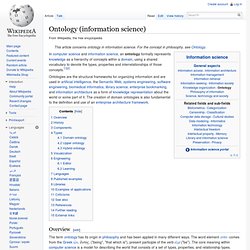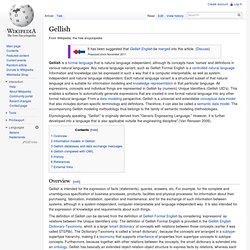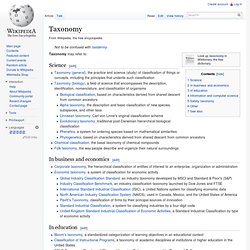

Semantic data model. Semantic data models.[1] A semantic data model in software engineering has various meanings: It is a conceptual data model in which semantic information is included.

This means that the model describes the meaning of its instances. Such a semantic data model is an abstraction that defines how the stored symbols (the instance data) relate to the real world.[1]It is a conceptual data model that includes the capability to express information that enables parties to the information exchange to interpret meaning (semantics) from the instances, without the need to know the meta-model. Such semantic models are fact oriented (as opposed to object oriented). Typically the instance data of semantic data models explicitly include the kinds of relationships between the various data elements, such as <is located in>. Overview[edit] History[edit] The need for semantic data models was first recognized by the U.S. Applications[edit] A semantic data model can be used to serve many purposes.
Data modeling. The data modeling process.

The figure illustrates the way data models are developed and used today. A conceptual data model is developed based on the data requirements for the application that is being developed, perhaps in the context of an activity model. The data model will normally consist of entity types, attributes, relationships, integrity rules, and the definitions of those objects. This is then used as the start point for interface or database design.[1] Data modeling in software engineering is the process of creating a data model for an information system by applying formal data modeling techniques. Overview[edit] Data modeling is a process used to define and analyze data requirements needed to support the business processes within the scope of corresponding information systems in organizations.
Data modeling techniques and methodologies are used to model data in a standard, consistent, predictable manner in order to manage it as a resource. Ontology (information science) In computer science and information science, an ontology formally represents knowledge as a hierarchy of concepts within a domain, using a shared vocabulary to denote the types, properties and interrelationships of those concepts.[1][2] Ontologies are the structural frameworks for organizing information and are used in artificial intelligence, the Semantic Web, systems engineering, software engineering, biomedical informatics, library science, enterprise bookmarking, and information architecture as a form of knowledge representation about the world or some part of it.

The creation of domain ontologies is also fundamental to the definition and use of an enterprise architecture framework. The term ontology has its origin in philosophy and has been applied in many different ways. The word element onto- comes from the Greek ὤν, ὄντος, ("being", "that which is"), present participle of the verb εἰμί ("be"). According to Gruber (1993): Common components of ontologies include: Gellish. Gellish is a formal language that is natural language independent, although its concepts have 'names' and definitions in various natural languages.

Any natural language variant, such as Gellish Formal English is a controlled natural language. Information and knowledge can be expressed in such a way that it is computer-interpretable, as well as system-independent and natural language independent. Each natural language variant is a structured subset of that natural language and is suitable for information modeling and knowledge representation in that particular language. All expressions, concepts and individual things are represented in Gellish by (numeric) Unique Identifiers (Gellish UID's). This enables a software to automatically generate expressions that are created in one formal natural language into any other formal natural language.
Etymologically speaking, "Gellish" is originally derived from "Generic Engineering Language. " Overview[edit] - query: what <is located in> Paris 1. GELLISH@WORK. Taxonomy. From Wikipedia, the free encyclopedia Taxonomy may refer to: Science[edit] In business and economics[edit] In education[edit] Bloom's taxonomy, a standardized categorization of learning objectives in an educational contextClassification of Instructional Programs, a taxonomy of academic disciplines at institutions of higher education in the United StatesSOLO Taxonomy, Structure of Observed Learning Outcome, proposed by Biggs and Collis Information and computer science[edit] ACM Computing Classification System, a subject classification system for computing devised by the Association for Computing MachineryXBRL Taxonomy, eXtensible Business Reporting LanguageSRK taxonomy, in workplace user-interface design.
